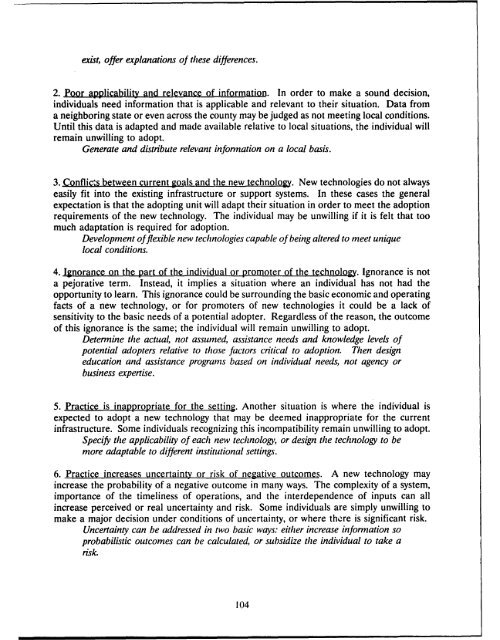Challenges and Opportunities for Innovation in the Public Works ...
Challenges and Opportunities for Innovation in the Public Works ...
Challenges and Opportunities for Innovation in the Public Works ...
Create successful ePaper yourself
Turn your PDF publications into a flip-book with our unique Google optimized e-Paper software.
exist, offer explanations of <strong>the</strong>se differences.<br />
2. Poor applicability <strong>and</strong> relevance of <strong>in</strong><strong>for</strong>mation. In order to make a sound decision,<br />
<strong>in</strong>dividuals need <strong>in</strong><strong>for</strong>mation that is applicable <strong>and</strong> relevant to <strong>the</strong>ir situation. Data from<br />
a neighbor<strong>in</strong>g state or even across <strong>the</strong> county may be judged as not meet<strong>in</strong>g local conditions.<br />
Until this data is adapted <strong>and</strong> made available relative to local situations, <strong>the</strong> <strong>in</strong>dividual will<br />
rema<strong>in</strong> unwill<strong>in</strong>g to adopt.<br />
Generate <strong>and</strong> distribute relevant <strong>in</strong><strong>for</strong>mation on a local basis.<br />
3. Conflicts between current goals <strong>and</strong> <strong>the</strong> new technolo . New technologies do not always<br />
easily fit <strong>in</strong>to <strong>the</strong> exist<strong>in</strong>g <strong>in</strong>frastructure or support systems. In <strong>the</strong>se cases <strong>the</strong> general<br />
expectation is that <strong>the</strong> adopt<strong>in</strong>g unit will adapt <strong>the</strong>ir situation <strong>in</strong> order to meet <strong>the</strong> adoption<br />
requirements of <strong>the</strong> new technology. The <strong>in</strong>dividual may be unwill<strong>in</strong>g if it is felt that too<br />
much adaptation is required <strong>for</strong> adoption.<br />
Development of flexible new technologies capable of be<strong>in</strong>g altered to meet unique<br />
local conditions.<br />
4. Ignorance on <strong>the</strong> part of <strong>the</strong> <strong>in</strong>dividual or promoter of <strong>the</strong> technology. Ignorance is not<br />
a pejorative term. Instead, it implies a situation where an <strong>in</strong>dividual has not had <strong>the</strong><br />
opportunity to learn. This ignorance could be surround<strong>in</strong>g <strong>the</strong> basic economic <strong>and</strong> operat<strong>in</strong>g<br />
facts of a new technology, or <strong>for</strong> promoters of new technologies it could be a lack of<br />
sensitivity to <strong>the</strong> basic needs of a potential adopter. Regardless of <strong>the</strong> reason, <strong>the</strong> outcome<br />
of this ignorance is <strong>the</strong> same; <strong>the</strong> <strong>in</strong>dividual will rema<strong>in</strong> unwill<strong>in</strong>g to adopt.<br />
Determ<strong>in</strong>e <strong>the</strong> actual, not assumed, assistance needs <strong>and</strong> knowledge levels of<br />
potential adopters relative to those factors critical to adoption. Then design<br />
education <strong>and</strong> assistance programs based on <strong>in</strong>dividual needs, not agency or<br />
bus<strong>in</strong>ess expertise.<br />
5. Practice is <strong>in</strong>appropriate <strong>for</strong> <strong>the</strong> sett<strong>in</strong>g. Ano<strong>the</strong>r situation is where <strong>the</strong> <strong>in</strong>dividual is<br />
expected to adopt a new technology that may be deemed <strong>in</strong>appropriate <strong>for</strong> <strong>the</strong> current<br />
<strong>in</strong>frastructure. Some <strong>in</strong>dividuals recogniz<strong>in</strong>g this <strong>in</strong>compatibility rema<strong>in</strong> unwill<strong>in</strong>g to adopt.<br />
Specify <strong>the</strong> applicability of each new technology, or design <strong>the</strong> technology to be<br />
more adaptable to different <strong>in</strong>stitutional sett<strong>in</strong>gs.<br />
6. Practice <strong>in</strong>creases uncerta<strong>in</strong>ty or risk of negative outcomes. A new technology may<br />
<strong>in</strong>crease <strong>the</strong> probability of a negative outcome <strong>in</strong> many ways. The complexity of a system,<br />
importance of <strong>the</strong> timel<strong>in</strong>ess of operations, <strong>and</strong> <strong>the</strong> <strong>in</strong>terdependence of <strong>in</strong>puts can all<br />
<strong>in</strong>crease perceived or real uncerta<strong>in</strong>ty <strong>and</strong> risk. Some <strong>in</strong>dividuals are simply unwill<strong>in</strong>g to<br />
make a major decision under conditions of uncerta<strong>in</strong>ty, or where <strong>the</strong>re is significant risk.<br />
Uncerta<strong>in</strong>ty can be addressed <strong>in</strong> two basic ways: ei<strong>the</strong>r <strong>in</strong>crease <strong>in</strong><strong>for</strong>mation so<br />
probabilistic outcomes can be calculated, or subsidize <strong>the</strong> <strong>in</strong>dividual to take a<br />
risk<br />
104







